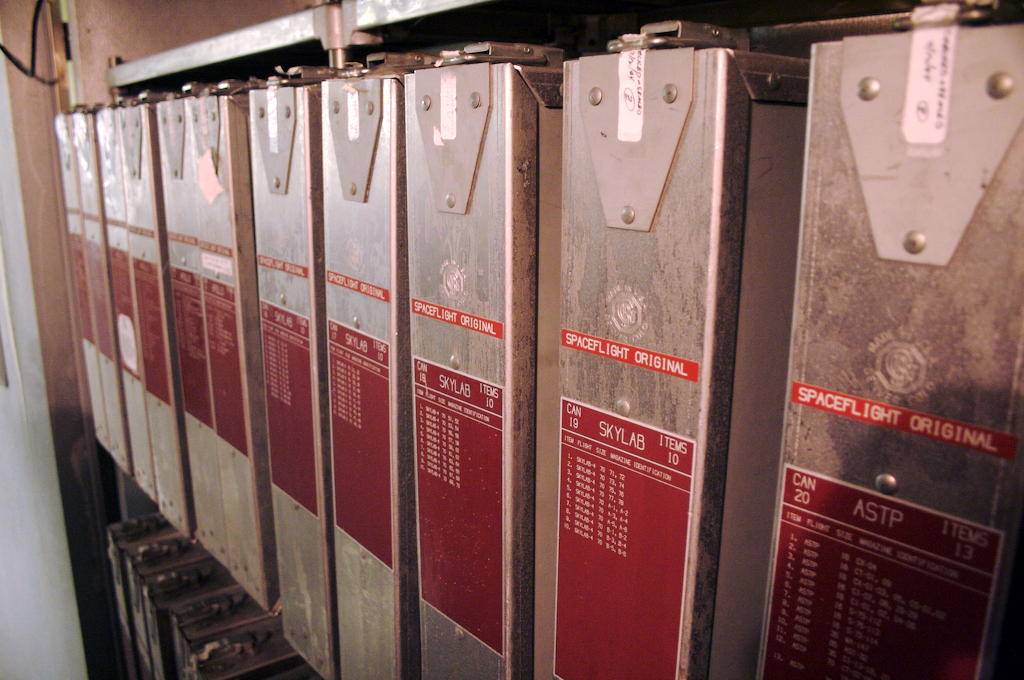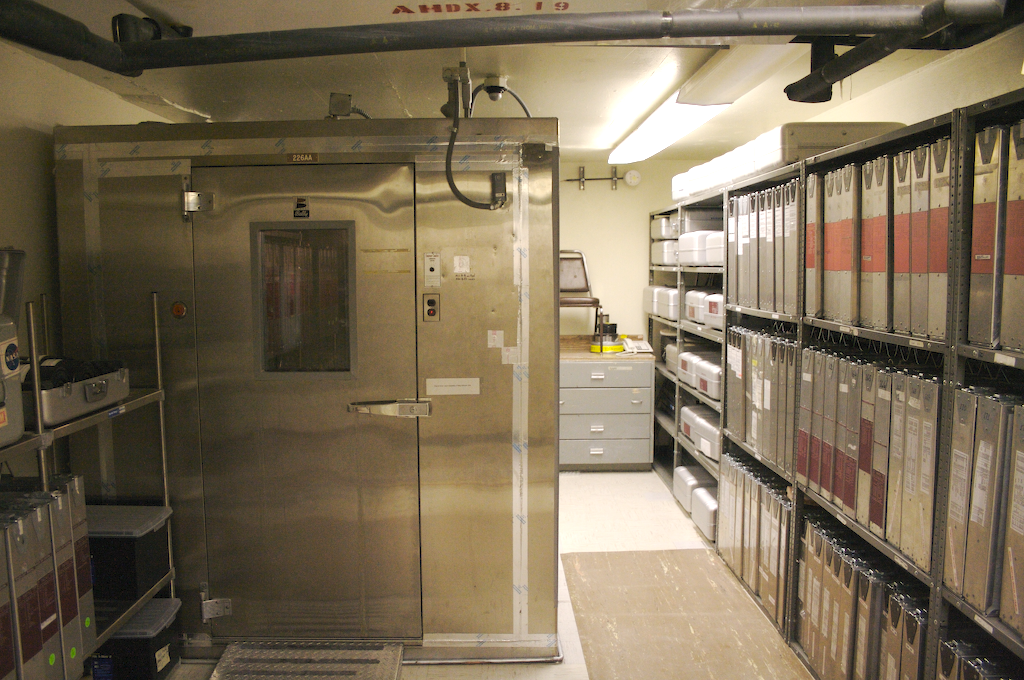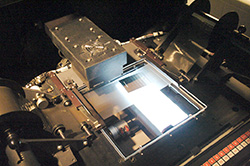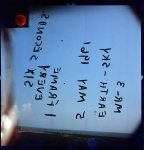About the Film Scans
Film Storage & Cleaning
Storing the Film
The goal of this program is to preserve the Apollo flight film products - in both the digital and physical formats - for generations to come. All the original Apollo film can be found in the Film Archive (Building 8) at Johnson Space Center (JSC). Due to the importance in preserving these films, the original film is not allowed to leave the building. The film is stored in a freezer (0° F), which is located in a large refrigerator that is maintained at 55° F. The staff at JSC has a rigorous procedure for removing film from the freezer for scanning or making copies.
- The sealed film canister is transferred from the freezer to the refrigerator where it is allowed to equilibrate for 24 hours.
- The sealed canister is then removed from the refrigerator and placed in a room temperature environment and allowed to equilibrate for an additional 24 hours.
- The film is then removed from the canister, hand cleaned (see below) and scanned.
- The film is placed back in the canister, sealed, and then placed back in the cold vault.



Cleaning the Film
These films have been in deep storage since the 1980s; prior to that, they were exposed to the space environment, developed, and occasionally used for research activities. Consequently, the preserved film stocks have, in some cases, acquired foreign material. Prior to scanning, each film roll is therefore gently, non-abrasively cleaned using exacting procedures set forth by the NASA-JSC curatorial staff. Absolutely no abrasive techniques are used in the cleaning of these films to preclude the possibility of damage to these priceless historical treasures. As a consequence of this precaution, the cleaning process only removes debris that is loosely adhered to the film stock (e.g. dust and lint) but any strongly adhered debris are simply left on the film.
Scanning the Film
Scans are acquired by Johnson Space Center. Rob Ingram was responsible for scanning the Mercury, Gemini, and Apollo films. Mary Wilkerson validated the originally named/cataloged film. All the 35 mm photographs were scanned first (about 620 frames), then the Metric camera's 10,153 frames (BW) were scanned, then the 4,612 frames from the Panoramic camera (BW) were scanned. Finally, the approximately 20,000 Hasselblad photographs (BW, and color) were scanned.
Mercury & Gemini
The Mercury and Gemini flight film negatives were scanned with Oxberry 35 mm (Fig. 4) and 70 mm systems.
The Oxberry systems use the Kodak HR-500 scanner, which incorporates the Kodak KLI-6013 tri-linear line sensor (one line each for red, green, and blue). Dark signal correction and flat-fielding are performed automatically during standard scan operations. Scans are digitized as 8-bit numbers (DN range 0-255) per channel (24-bits total for RGB composite).
The Oxberry 70 mm system was adjusted at the factory and in-house tests indicate the geometric fidelity is within 1 part in 3000 vertically, and better than 1 part in 6000 horizontally (assuming the film is properly aligned). The scans are 4410 samples by 4600 lines, and the file sizes are ~58 MB.
Apollo
Apollo scans are acquired with a Leica DSW700 photogrammetric scanner (Fig. 5) allowing for very high geometric and radiometric fidelity. In addition, the films are scanned at very high spatial resolutions up to 200 pixels/mm (5 microns) and an extended bit depth (14-bit A/D) (16,384 shades of grey) in order to ensure that as much of the information content of the film is preserved.
The DSW700 was modified from the original 12-bit A/D to a 14-bit A/D because the Moon is a very high-contrast target and the original film is capable of capturing a very wide range of grey scale variation. The combination of small pixels (5 micron) and the 14-bit gray scale results in a very detailed scan and, of course, very large raw scan files. Metric film scans are approximately 1.3 GB each and panoramic film tiles are 1.9 GB each and require eight tiles for a single panoramic image.
The Apollo 35 mm films are scanned using Oxbery 35 mm system, much like the Mercury and Gemini 35 mm films.


Cameras
Hasselblad 500c 70 mm Camera
The Hasselblad 500c is a Swedish designed medium format single lens reflex camera that was first introduced in 1957. The camera was fitted with a Carl Zeiss lens with a built-in leaf shutter. This camera was renowned for its clarity. The camera that was taken to space was modified to make it lighter and sent up on the first Mercury mission. The consumer version was first carried to space by astronaut Walter Schirra when he piloted Mercury 8. It became the foundation of a line of cameras which was used by Neil Armstrong and Buzz Aldrin to record the first images of humans on the Moon. The astronauts used a motor-driven Hasselblad 500EL/70 (70 mm film back) Data Camera fitted with a reseau plate. Traditional lubricants were replaced by a low friction alternative and metal plating was used instead of the standard black leatherette covering.
Maurer 220G 70 mm Camera
Initially designed and built by engineer John Maurer, J.A. Maurer Inc., for NASA during Project Mercury, these 70 mm format cameras along with a series of different film types, lenses, and filters were utiilzed for scientific photography experiments during both uncrewed and crewed missions. Early Mercury missions window-mounted a Maurer sequence camera in order to get time-lapse photos on uncrewed missions, but the cameras were also later used on crewed missions for both window-mounted sequences and handheld photography, and their use continued into some of the early Apollo missions.
Apollo Lunar Surface Close-up Camera
As the name implies, this camera was designed to produce detailed stereoscopic imagery of the lunar surface during Apollo 11, 12, and 14 mission surface operations. The Apollo Lunar Surface Close-up Camera (ALSCC) is a twin-lens, stereoscopic camera built by Eastman Kodak. The two lenses were 46.12 mm f/17 Kodak M-39 copy lenses mounted 29 mm apart, focused for an object distance of 184.5 mm and provided an image magnification of 0.33.
For the sake of simplicity, the camera had a fixed focus and flash exposure and was loaded with Ektachrome MS (SO368) film prior to launch. To take an image, an astronaut simply had to place the camera over the area to be imaged and press the trigger that was located on the camera handle and the film was automatically advanced to the next frame and the flash recharged. The photographed area is 72 mm x 82.8 mm centered between the optical axes of the lenses.
Nikon 35 mm Camera
The Nikon cameras used on board the Apollo Command Modules sported a 55 mm lens with either black-and-white film or color film. During Apollo 16 and 17, black-and-white film enabled dim-light photography of astronomical phenomena and lunar surface targets illuminated by Earthshine. During Apollo 17, color film was used for documenting various activities in the Command Module.
Apollo Metric & Panoramic Cameras
The metric and panoramic camera films can be viewed and downloaded at the Apollo Image Archive. These digital scans will be migrated into the March to the Moon online archive in the near future.
Step Charts
What are they?
The step charts were created by placing density wedges directly on the film and exposed; no camera used in the process. As such, the step charts were often longer than a typical 70 mm frame, sometimes up to 5x the nominal length. In some film magazines, the wedges were staggered so that different densities are exposed next to each other. This placement allowed easy identification of off-nominal density variation from developing (or any other reason). The wedges have fixed percent densities from 100% opaque to 0% opaque. All the step charts are available for download as compressed files below.
- AS06-02-StepChart (920 MB)
- AS07-03-StepChart (1.6 GB)
- AS07-04-StepChart (1.6 GB)
- AS07-05-StepChart (1.6 GB)
- AS07-06-StepChart (1.6 GB)
- AS07-07-StepChart (1.6 GB)
- AS07-07-StepChart01 (1.5 GB)
- AS07-08-StepChart (1.6 GB)
- AS07-11-StepChart (1.6 GB)
- AS08-14-stepchart (600 MB)
- AS08-15-stepchart (610 MB)
- AS08-16-stepchart (600 MB)
- AS09-19-stepchart (570 MB)
- AS09-26A-stepchart (620 MB)
- AS10-27-stepchart (590 MB)
- AS10-34-stepchart (580 MB)
- AS10-35-stepchart (410 MB)
- AS11-036-StepChart (1.5 GB)
- AS11-037-StepChart (1.5 GB)
- AS11-040-StepChart (1.5 GB)
- AS11-044-StepChart (1.5 GB)
- AS11-36-StepChart (1.5 GB)
- AS11-37-StepChart (1.5 GB)
- AS11-40-StepChart (1.5 GB)
- AS11-44-StepChart (1.5 GB)
- AS12-46-StepChart (1.6 GB)
- AS12-47-StepChart (1.5 GB)
- AS12-50-StepChart (1.4 GB)
- AS12-51-StepChart (1.5 GB)
- AS13-58-StepChart (1.5 GB)
- AS13-60-StepChart (1.5 GB)
- AS13-61-StepChart (1.6 GB)
- AS13-62-StepChart (1.5 GB)
- AS14-66-StepChart (1.6 GB)
- AS14-67-StepChart (1.6 GB)
- AS14-72-StepChart (1.5 GB)
- AS14-73-StepChart (1.5 GB)
- AS14-74-StepChart (1.5 GB)
- AS14-76-StepChart (1.5 GB)
- AS15-86-StepChart (1.7 GB)
- AS15-87-StepChart (1.7 GB)
- AS15-88-StepChart (1.7 GB)
- AS15-91-StepChart (1.5 GB)
- AS15-93-StepChart (1.5 GB)
- AS15-96-StepChart (1.5 GB)
- AS15-97-StepChart (1.5 GB)
- AS16-107-StepChart (1.7 GB)
- AS16-111-stepchart01 (120 MB)
- AS16-111-stepchart02 (220 MB)
- AS16-111-stepchart03 (190 MB)
- AS16-111-stepchart04 (150 MB)
- AS16-111-stepchart05 (81 MB)
- AS16-113-StepChart (1.7 GB)
- AS16-114-StepChart (1.6 GB)
- AS16-115-StepChart (1.7 GB)
- AS16-116-StepChart (1.7 GB)
- AS16-117-StepChart (1.7 GB)
- AS16-118-StepChart (1.6 GB)
- AS16-119-StepChart (1.6 GB)
- AS16-120-StepChart (1.5 GB)
- AS16-121-StepChart (1.6 GB)
- AS16-122-StepChart (1.6 GB)
- AS17-134-StepChart (1.6 GB)
- AS17-137-StepChart (1.6 GB)
- AS17-140-StepChart (1.7 GB)
- AS17-145-StepChart (1.7 GB)
- AS17-146-StepChart (1.7 GB)
- AS17-147-StepChart (1.6 GB)
- AS17-148-StepChart (1.6 GB)
- AS17-149-StepChart (1.6 GB)
- AS17-150-StepChart (1.6 GB)
- AS17-151-StepChart (1.6 GB)
- AS17-152-StepChart (1.6 GB)
- AS17-153-StepChart (1.6 GB)
Acknowledgments
Many people have contributed efforts to make this program possible. First the Johnson Space Center Team does the bulk of the work applying their years of experience and quality control. LPI has provided much support data and valuable feedback. The National Air and Space Museum NASA Regional Planetary Image Facilities lent outreach and technical expertise. ASU students and staff have developed software, provided archiving expertise, and processed scans to final products. The USGS Branch of Astrogeology provided valuable assistance evaluating test scans and discussing instrument geometry and lunar coordinates. The NASA Ames Research Center provided test scan evaluations and inputs on camera geometry and stereo analysis. Leica Geosystems provided excellent support during the proposal stage and has worked hard to maximize the capabilities of the scanner.
Jim Garvin (GSFC) and John Grunsfeld (JSC) played key roles during the proposal stage of the program, and NASA's Exploration Systems Mission Directorate (ESMD) has generously provided the funding to make this program possible.
| JSC Team |
|---|
| Will Close |
| Robert Bode |
| John Grunsfeld |
| Rob Ingram |
| Larry Jefferson |
| Sheryl Locke |
| Roger Mitchell |
| Tom Scarsella |
| Maura White |
| Warren Harold |
| Rodney Dowell |
| Mary Wilkerson |
| Samuel Lawrence |
| LPI Team |
|---|
| Mary Ann Hager |
| Steve Mackwell |
| NASM Team |
|---|
| Tom Waters |
| Mark Salvatore |
| Jennifer Levasseur |
| USGS Team |
|---|
| Brent Archinal |
| Randy Kirk |
| Mark Rosiek |
| NASA Ames Research Center |
|---|
| Michael Broxton |
| Laurence Edwards |
| Leica Team |
|---|
| Alex Dam |
| Andy Calarco |
| ASU Team |
|---|
| Mark Robinson |
| Ernest Bowman-Cisneros |
| Nick Estes |
| Emerson Speyerer |
| Kristen Paris |
| Aaron Boyd |
| Jeff Leland |
| Rick Hoppe |
| Jacob Danton |
| Sean Merritt |
| Carmen Sales |
| Dan Stanzione |
| Veronica Ann Zabala-Aliberto |
| Lilian Otteson |
| John Low |
| Kunal Lenjewar |
| Omar Lopez |
| Kris Pouncy |
Frequently Asked Questions

Many of the Mercury images have hand written annotations on the film, which may seem odd now. Remember that the Mercury flights were engineering tests - NASA was inventing human spaceflight. The frames were marked to facilitate analysis, plain and simple. One can view the notations as dedication to the cause, a signal of the urgency to succeed.
The 35 mm frames from the ALSCC are closeups of the regolith with little contrast and thus were not processed into the full suite of products (to preserve their full dynamic range).
Acceptable Use Policy
Raw Scans
Digital scans of Mercury, Gemini, and Apollo flight films by NASA (Metric, Panoramic, ALSCC, 70mm Hasselblad, 35mm Nikon and Stellar) in their raw (unprocessed) form are in the public domain and as such are covered by NASA usage policy for still image and computer files (see here).
Processed Images
Arizona State University retains the rights to any derived products (such as post-scanning processed digital images and movies), in part and in whole with a non-exclusive, non-transferable license. ASU hereby grants permission for news media, educators, personal, and scientific users to download and use individual ASU-produced Apollo images and their complete associated captions if applicable for personal, educational, and research uses without express permission. Processed images should be credited using the line "NASA/JSC/Arizona State University" or "NASA/JSC/ASU".
These images, and associated derived products, may not be used in any commercial or business environment or for any commercial or business purposes for yourself or any third parties. These images, and their associated derived products, may not be copied, reverse engineered, decompiled, disassembled, translated, modified or have derivative works made of the imagery, in whole or in part. You also may not rent, disclose, publish, sell, assign, lease, sub-license, market, or transfer the imagery or any part thereof or use it in any manner not expressly authorized.
For information about how to distinguish raw film scans from processed digital image files, please view the image processing section above.
For questions and concerns, please utilize the contact form.